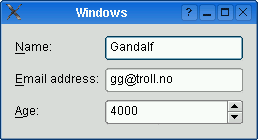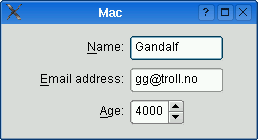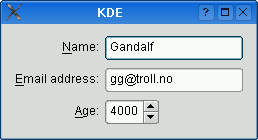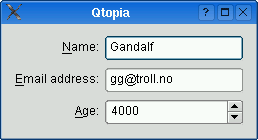QFormLayout ClassThe QFormLayout class manages forms of input widgets and their associated labels. More... #include <QFormLayout>Inherits: QLayout. This class was introduced in Qt 4.4. Public Types
Properties
Public Functions
Reimplemented Public Functions
Static Public Members
Protected Functions
Additional Inherited MembersDetailed DescriptionThe QFormLayout class manages forms of input widgets and their associated labels. QFormLayout is a convenience layout class that lays out its children in a two-column form. The left column consists of labels and the right column consists of "field" widgets (line editors, spin boxes, etc.). Traditionally, such two-column form layouts were achieved using QGridLayout. QFormLayout is a higher-level alternative that provides the following advantages:
The table below shows the default appearance in different styles.
The form styles can be also be overridden individually by calling setLabelAlignment(), setFormAlignment(), setFieldGrowthPolicy(), and setRowWrapPolicy(). For example, to simulate the form layout appearance of QMacStyle on all platforms, but with left-aligned labels, you could write: formLayout->setRowWrapPolicy(QFormLayout::DontWrapRows); formLayout->setFieldGrowthPolicy(QFormLayout::FieldsStayAtSizeHint); formLayout->setFormAlignment(Qt::AlignHCenter | Qt::AlignTop); formLayout->setLabelAlignment(Qt::AlignLeft); See also QGridLayout, QBoxLayout, and QStackedLayout. Member Type Documentation
|
| Constant | Value | Description |
|---|---|---|
| QFormLayout::FieldsStayAtSizeHint | 0 | The fields never grow beyond their effective size hint. This is the default for QMacStyle. |
| QFormLayout::ExpandingFieldsGrow | 1 | Fields with an horizontal size policy of Expanding or MinimumExpanding will grow to fill the available space. The other fields will not grow beyond their effective size hint. This is the default policy for Plastique. |
| QFormLayout::AllNonFixedFieldsGrow | 2 | All fields with a size policy that allows them to grow will grow to fill the available space. This is the default policy for most styles. |
See also fieldGrowthPolicy.
enum QFormLayout::ItemRole
This enum specifies the types of widgets (or other layout items) that may appear in a row.
| Constant | Value | Description |
|---|---|---|
| QFormLayout::LabelRole | 0 | A label widget. |
| QFormLayout::FieldRole | 1 | A field widget. |
| QFormLayout::SpanningRole | 2 | A widget that spans label and field columns. |
See also itemAt() and getItemPosition().
enum QFormLayout::RowWrapPolicy
This enum specifies the different policies that can be used to control the way in which the form's rows wrap.
| Constant | Value | Description |
|---|---|---|
| QFormLayout::DontWrapRows | 0 | Fields are always laid out next to their label. This is the default policy for all styles except Qt Extended styles. |
| QFormLayout::WrapLongRows | 1 | Labels are given enough horizontal space to fit the widest label, and the rest of the space is given to the fields. If the minimum size of a field pair is wider than the available space, the field is wrapped to the next line. This is the default policy for Qt Extended styles. |
| QFormLayout::WrapAllRows | 2 | Fields are always laid out below their label. |
See also rowWrapPolicy.
Property Documentation
fieldGrowthPolicy : FieldGrowthPolicy
This property holds the way in which the form's fields grow.
The default value depends on the widget or application style. For QMacStyle, the default is FieldsStayAtSizeHint; for QCommonStyle derived styles (like Plastique and Windows), the default is ExpandingFieldsGrow; for Qt Extended styles, the default is AllNonFixedFieldsGrow.
If none of the fields can grow and the form is resized, extra space is distributed according to the current form alignment.
Access functions:
| FieldGrowthPolicy | fieldGrowthPolicy() const |
| void | setFieldGrowthPolicy(FieldGrowthPolicy policy) |
See also formAlignment and rowWrapPolicy.
formAlignment : Qt::Alignment
This property holds the alignment of the form layout's contents within the layout's geometry.
The default value depends on the widget or application style. For QMacStyle, the default is Qt::AlignHCenter | Qt::AlignTop; for the other styles, the default is Qt::AlignLeft | Qt::AlignTop.
Access functions:
| Qt::Alignment | formAlignment() const |
| void | setFormAlignment(Qt::Alignment alignment) |
See also labelAlignment and rowWrapPolicy.
horizontalSpacing : int
This property holds the spacing between widgets that are laid out side by side.
By default, if no value is explicitly set, the layout's horizontal spacing is inherited from the parent layout, or from the style settings for the parent widget.
Access functions:
| int | horizontalSpacing() const |
| void | setHorizontalSpacing(int spacing) |
See also verticalSpacing, QStyle::pixelMetric(), and PM_LayoutHorizontalSpacing.
labelAlignment : Qt::Alignment
This property holds the horizontal alignment of the labels.
The default value depends on the widget or application style. For QCommonStyle derived styles, except for QPlastiqueStyle, the default is Qt::AlignLeft; for the other styles, the default is Qt::AlignRight.
Access functions:
| Qt::Alignment | labelAlignment() const |
| void | setLabelAlignment(Qt::Alignment alignment) |
See also formAlignment.
rowWrapPolicy : RowWrapPolicy
This property holds the way in which the form's rows wrap.
The default value depends on the widget or application style. For Qt Extended styles, the default is WrapLongRows; for the other styles, the default is DontWrapRows.
If you want to display each label above its associated field (instead of next to it), set this property to WrapAllRows.
Access functions:
| RowWrapPolicy | rowWrapPolicy() const |
| void | setRowWrapPolicy(RowWrapPolicy policy) |
See also fieldGrowthPolicy.
verticalSpacing : int
This property holds the spacing between widgets that are laid out vertically.
By default, if no value is explicitly set, the layout's vertical spacing is inherited from the parent layout, or from the style settings for the parent widget.
Access functions:
| int | verticalSpacing() const |
| void | setVerticalSpacing(int spacing) |
See also horizontalSpacing, QStyle::pixelMetric(), and PM_LayoutHorizontalSpacing.
Member Function Documentation
QFormLayout::QFormLayout(QWidget * parent = 0)
Constructs a new form layout with the given parent widget.
See also QWidget::setLayout().
QFormLayout::~QFormLayout()
Destroys the form layout.
void QFormLayout::addItem(QLayoutItem * item) [virtual]
Reimplemented from QLayout::addItem().
void QFormLayout::addRow(QWidget * label, QWidget * field)
Adds a new row to the bottom of this form layout, with the given label and field.
See also insertRow().
void QFormLayout::addRow(QWidget * label, QLayout * field)
This is an overloaded function.
void QFormLayout::addRow(const QString & labelText, QWidget * field)
This is an overloaded function.
This overload automatically creates a QLabel behind the scenes with labelText as its text. The field is set as the new QLabel's buddy.
void QFormLayout::addRow(const QString & labelText, QLayout * field)
This is an overloaded function.
This overload automatically creates a QLabel behind the scenes with labelText as its text.
void QFormLayout::addRow(QWidget * widget)
This is an overloaded function.
Adds the specified widget at the end of this form layout. The widget spans both columns.
void QFormLayout::addRow(QLayout * layout)
This is an overloaded function.
Adds the specified layout at the end of this form layout. The layout spans both columns.
int QFormLayout::count() const [virtual]
Reimplemented from QLayout::count().
Qt::Orientations QFormLayout::expandingDirections() const [virtual]
Reimplemented from QLayoutItem::expandingDirections().
void QFormLayout::getItemPosition(int index, int * rowPtr, ItemRole * rolePtr) const
Retrieves the row and role (column) of the item at the specified index. If index is out of bounds, *rowPtr is set to -1; otherwise the row is stored in *rowPtr and the role is stored in *rolePtr.
See also itemAt(), count(), getLayoutPosition(), and getWidgetPosition().
void QFormLayout::getLayoutPosition(QLayout * layout, int * rowPtr, ItemRole * rolePtr) const
Retrieves the row and role (column) of the specified child layout. If layout is not in the form layout, *rowPtr is set to -1; otherwise the row is stored in *rowPtr and the role is stored in *rolePtr.
void QFormLayout::getWidgetPosition(QWidget * widget, int * rowPtr, ItemRole * rolePtr) const
Retrieves the row and role (column) of the specified widget in the layout. If widget is not in the layout, *rowPtr is set to -1; otherwise the row is stored in *rowPtr and the role is stored in *rolePtr.
See also getItemPosition() and itemAt().
bool QFormLayout::hasHeightForWidth() const [virtual]
Reimplemented from QLayoutItem::hasHeightForWidth().
int QFormLayout::heightForWidth(int width) const [virtual]
Reimplemented from QLayoutItem::heightForWidth().
void QFormLayout::insertRow(int row, QWidget * label, QWidget * field)
Inserts a new row at position row in this form layout, with the given label and field. If row is out of bounds, the new row is added at the end.
See also addRow().
void QFormLayout::insertRow(int row, QWidget * label, QLayout * field)
This is an overloaded function.
void QFormLayout::insertRow(int row, const QString & labelText, QWidget * field)
This is an overloaded function.
This overload automatically creates a QLabel behind the scenes with labelText as its text. The field is set as the new QLabel's buddy.
void QFormLayout::insertRow(int row, const QString & labelText, QLayout * field)
This is an overloaded function.
This overload automatically creates a QLabel behind the scenes with labelText as its text.
void QFormLayout::insertRow(int row, QWidget * widget)
This is an overloaded function.
Inserts the specified widget at position row in this form layout. The widget spans both columns. If row is out of bounds, the widget is added at the end.
void QFormLayout::insertRow(int row, QLayout * layout)
This is an overloaded function.
Inserts the specified layout at position row in this form layout. The layout spans both columns. If row is out of bounds, the widget is added at the end.
void QFormLayout::invalidate() [virtual]
Reimplemented from QLayoutItem::invalidate().
QLayoutItem * QFormLayout::itemAt(int row, ItemRole role) const
Returns the layout item in the given row with the specified role (column). Returns 0 if there is no such item.
See also QLayout::itemAt() and setItem().
QLayoutItem * QFormLayout::itemAt(int index) const [virtual]
Reimplemented from QLayout::itemAt().
QWidget * QFormLayout::labelForField(QWidget * field) const
Returns the label associated with the given field.
See also itemAt().
QWidget * QFormLayout::labelForField(QLayout * field) const
This is an overloaded function.
QSize QFormLayout::minimumSize() const [virtual]
Reimplemented from QLayoutItem::minimumSize().
int QFormLayout::rowCount() const
Returns the number of rows in the form.
See also QLayout::count().
void QFormLayout::setGeometry(const QRect & rect) [virtual]
Reimplemented from QLayoutItem::setGeometry().
void QFormLayout::setItem(int row, ItemRole role, QLayoutItem * item)
Sets the item in the given row for the given role to item, extending the layout with empty rows if necessary.
If the cell is already occupied, the item is not inserted and an error message is sent to the console. The item spans both columns.
Warning: Do not use this function to add child layouts or child widget items. Use setLayout() or setWidget() instead.
See also setLayout().
void QFormLayout::setLayout(int row, ItemRole role, QLayout * layout)
Sets the sub-layout in the given row for the given role to layout, extending the form layout with empty rows if necessary.
If the cell is already occupied, the layout is not inserted and an error message is sent to the console.
Note: For most applications, addRow() or insertRow() should be used instead of setLayout().
See also setWidget().
void QFormLayout::setSpacing(int spacing)
This function sets both the vertical and horizontal spacing to spacing.
See also spacing(), setVerticalSpacing(), and setHorizontalSpacing().
void QFormLayout::setWidget(int row, ItemRole role, QWidget * widget)
Sets the widget in the given row for the given role to widget, extending the layout with empty rows if necessary.
If the cell is already occupied, the widget is not inserted and an error message is sent to the console.
Note: For most applications, addRow() or insertRow() should be used instead of setWidget().
See also setLayout().
QSize QFormLayout::sizeHint() const [virtual]
Reimplemented from QLayoutItem::sizeHint().
int QFormLayout::spacing() const
If the vertical spacing is equal to the horizontal spacing, this function returns that value; otherwise it returns -1.
See also setSpacing(), verticalSpacing(), and horizontalSpacing().
QLayoutItem * QFormLayout::takeAt(int index) [virtual]
Reimplemented from QLayout::takeAt().























